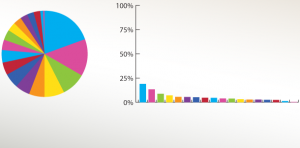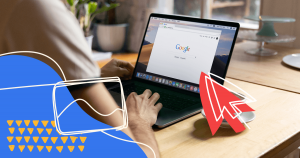These days, it’s not enough for brands to maintain a solid web presence and a robust working knowledge of current eCommerce practices.
With mobile devices like smartphones and tablets becoming increasingly sophisticated, mobile has quickly become the digital-age consumer’s preferred way to browse, research, and even buy online.
For that reason, modern companies can no longer afford not to include mobile marketing in their ongoing eCommerce strategy, making a complete understanding of mobile commerce (or m-commerce) a must.
Here’s a closer look at what m-commerce is all about, as well as some pointers on how to get started. You’ll be an m-commerce boss before you know it.
- What is Mobile Commerce?
- Ecommerce vs M-Commerce
- The Benefits of M-Commerce
- How to Do M-Commerce
- Examples of Mobile Commerce
- Wrap Up
What is Mobile Commerce?
Also called m-commerce for short, mobile commerce is a term that describes any online monetary action completed via a smartphone, tablet, or other mobile devices.
As a concept, it’s the direct descendent of the electronic commerce (eCommerce) you’re already familiar with.
It simply takes things a step further by making it possible to buy, sell, shop, or otherwise manage purchase decisions via mobile.
That said, many standard transaction types fall under the mobile commerce umbrella.
Yes, mobile shopping and purchasing are a big part of the equation. However, making payments, banking, and completing money transfers online are also considered forms of m-commerce.
Ecommerce vs M-Commerce
Although eCommerce and m-commerce are closely related, they’re not the same.
eCommerce refers to a wide variety of online commercial activities. These naturally include both buying and selling, but related actions like communication, negotiation, information exchange, and payment are all part of the mix, too.
M-commerce is the inevitable offshoot of eCommerce made possible as the use of mobile devices has grown more prevalent.
Throughout 2021, over 90 percent of global internet users used their mobile devices to access the internet.
Many of them sold and bought things, transferred money, or made payments via their devices, and those numbers are only expected to keep growing.
So to summarize, if eCommerce covers the complete experience of shopping online, then m-commerce shines a special spotlight on the portion of the buyer’s journey that occurs over mobile devices.
The Benefits of M-Commerce
Now that mobile is the preferred way to do just about anything online, including buying and selling, the benefits of m-commerce are numerous. Here are a few of the most important ones.
Customers enjoy faster transactions
These days, timeliness isn’t just the order of the day for businesses.
The growth of mobile technology means modern consumers are used to speed and convenience when it comes to their internet use.
M-commerce makes it easier for online merchants and service providers to deliver the shopping experience their customers now want and expect.
You reach customers at the right time
Successful digital marketing is about more than simply getting through to a customer and selling them on the benefits of buying something.
It’s also about reaching them at precisely the right time — at the very moment they decide to finalize a purchase.
Adding an m-commerce strategy to your repertoire takes the guesswork out of this, thanks to advertising tech that leverages location and other important demographic information.
You have more opportunities to reach customers
Adding m-commerce to a digital marketing strategy means a modern business enjoys more opportunities than ever to connect with their customers and potentially close a sale.
This isn’t just the case for companies that operate strictly online, either.
Many traditional shoppers still use the internet to research products and read reviews before arriving to complete a purchase in person, making m-commerce a must even for brick-and-mortar businesses.
How to Do M-Commerce
Now that you know why m-commerce is important and understand the benefits of making it part of your ongoing approach to eCommerce, it’s time to learn how to incorporate it into your digital marketing strategy. Here’s how to get started.
1. Optimize your website for mobile
According to John Mueller of Google, the average web visitor is only willing to wait two seconds for a particular web page to load before looking for what they need elsewhere.
However, the average load speed for a page is around 3.21 seconds.
The slower your load speeds, the higher your bounce rates, so figure out what your current mobile load speeds are and minimize them as much as possible by:
- Optimizing all of your images with mobile in mind.
- Use a tool like Google Tag Manager to automate and simplify tracking snippets.
- Minimize your code by culling unnecessary whitespace from JavaScript, CSS, and HTML.
2. Enable a variety of payment options
Today’s shoppers like having plenty of options to choose from when it comes to paying for goods and services, especially when shopping via mobile.
Many of your customers will still choose to pay with a traditional credit or debit card, but alternative options like PayPal, Stripe, or Apple Pay are also increasingly popular.
If a shopper sees they can’t use their payment method of choice, you’re likely to lose that sale altogether, so offer your customers as many different options as possible. That way, the choice is up to them.
3. Streamline your checkout sequence
Around 70 percent of web shoppers abandon their carts at some point during the checkout process, so it literally pays to make your checkout process as simple, fast, and streamlined as possible.
For example, many people don’t like being required to create an account on a website just to complete one purchase, so offer a guest checkout feature with an option to create an account later.
Avoid including too many steps in your checkout process, as people definitely have limited patience for that sort of thing, especially if they’re on the go.
They don’t like being surprised by charges they didn’t expect, either. So if you’ll be charging tax, shipping, or service fees, let people know that up front.
4. Build a native app
Given the choice between shopping via a standard website and using a native app, 78 percent of online shoppers say they’d prefer the app.
That said, developing a native app is one of the better ways you can improve the m-commerce experience for your customers and ensure your brand lives up to changing consumer expectations.
Apps are faster and more streamlined. They simplify the customer experience by storing personal information for easy use.
Apps also suit the mobile shopping experience better than even the best mobile website ever will.
Just make sure your app is consistent with not only your brand but the full functionality of your existing online store for a cohesive customer experience.
5. Optimize customer support for m-commerce
M-commerce customers aren’t just looking to research, browse, and purchase your products via their mobile devices.
They want to be able to use those same devices to get in touch with your support department with questions or concerns, as well.
As with payment options, each of your customers will have their own preference as far as how and where to contact you, so an omnichannel approach is generally best.
Options like chatbots, WhatsApp, or Facebook Messenger provide easy, familiar solutions for customers who need instant support and want to talk to a support agent in real-time.
However, many customers still prefer traditional options like email, telephone, or online voice services, so be sure to offer those, too.
Examples of Mobile Commerce
Curious about what a well-executed m-commerce effort looks like in action? The following companies are definitely getting m-commerce right, so prepare to be inspired.
Dominos
Dominos has had a good read on m-commerce since long before it went mainstream, so they’ve definitely earned a mention here.
Their “skip the line” campaign is especially noteworthy for creating a seamless connection between their online and offline experiences.
Takeaway customers who use the Dominos Pie Pass option get to order ahead online and then literally skip the line when it’s time to pick up their finished order.
Not only does this make the process of ordering from Dominos easier, but it helps make loyal customers feel just like VIPs.
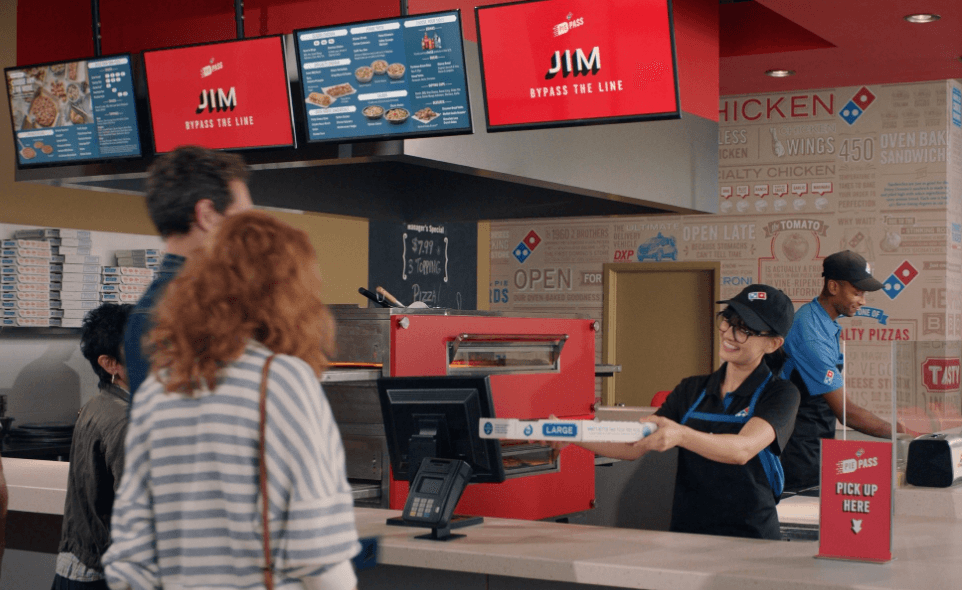
Zappos
Zappos has been famous for its stellar customer service and focus on meeting consumer expectations for many years now.
However, it’s their enhanced mobile app that really makes them a contender in the m-commerce game.
Said app includes several different features that make shopping with Zappos simple, convenient, and fun, including:
- The ability to contact Zappos directly from the app via email or SMS.
- Access to an Ask Zappos team that does everything from researching products for customers to giving them directions.
- An original card reader that makes shopping with a card easy and secure.
- Stylist-curated collections that simplify the process of browsing for special events, holidays, and more.
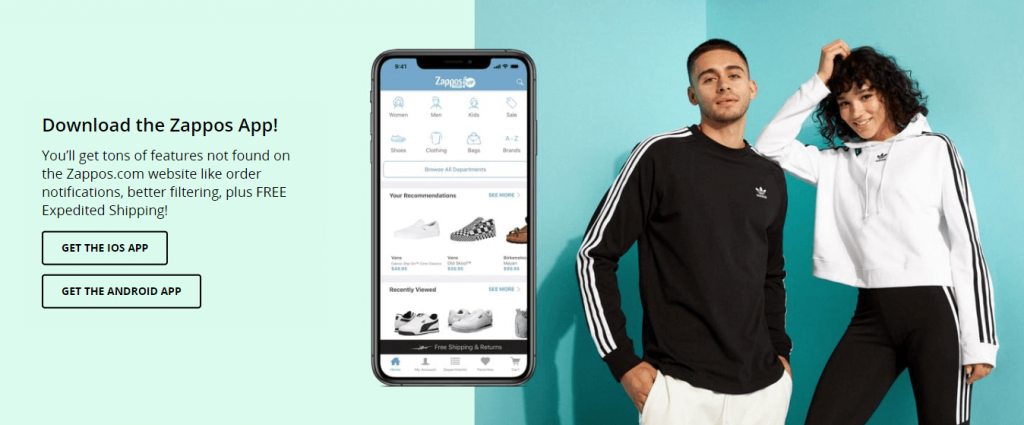
1-800-FLOWERS
1-800-FLOWERS was already at the top of the heap when it comes to flower delivery for lots of great reasons.
The investments they’ve made in m-commerce have given their customers one more.
The one-tap gift option on their mobile app lets shoppers enjoy an ultra-speedy checkout process — perfect for shopping on the go or making last-minute purchases.
Customers have a number of options to choose from should they need to get in touch with support about an order, including Apple Business Chat and iMessage.
They can select a variety of payment options, as well, including popular digital wallet picks like Venmo.
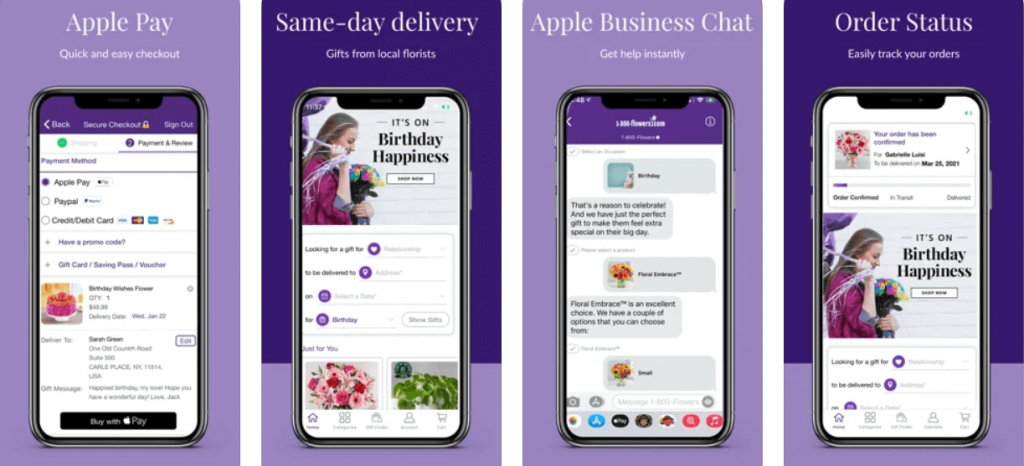
Wrap Up
Even online stores that are already doing well can always do a little better, so it’s essential to ensure your eCommerce campaign keeps up with current trends.
M-commerce is one of the most important, as today’s customer wants, needs, and expects to be able to finalize their purchases via mobile.
Check out our comprehensive write-up on key eCommerce optimization strategies to know now, throughout this year, and into the future.
You will learn more about ideal eCommerce conversion rates, discover hot tips for staying ahead of the game, and more!







